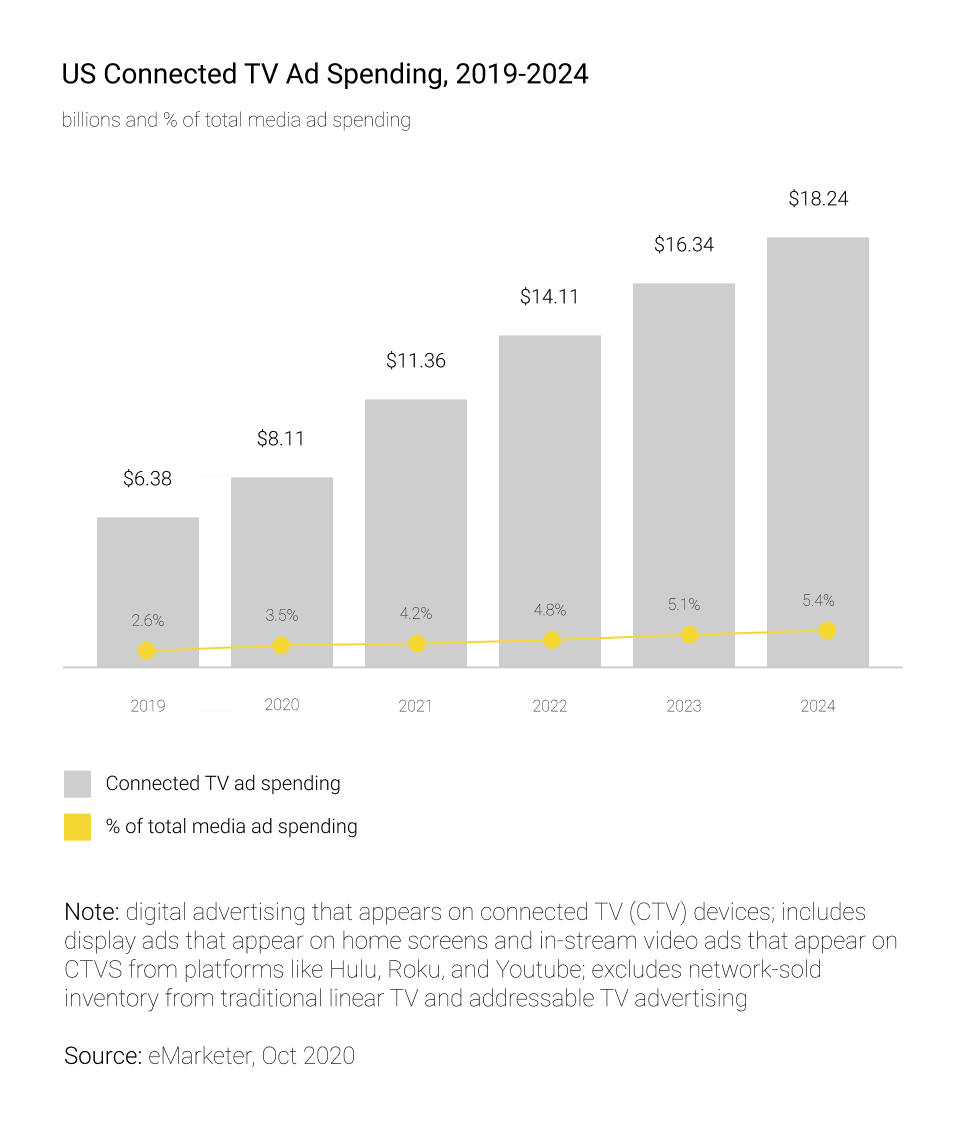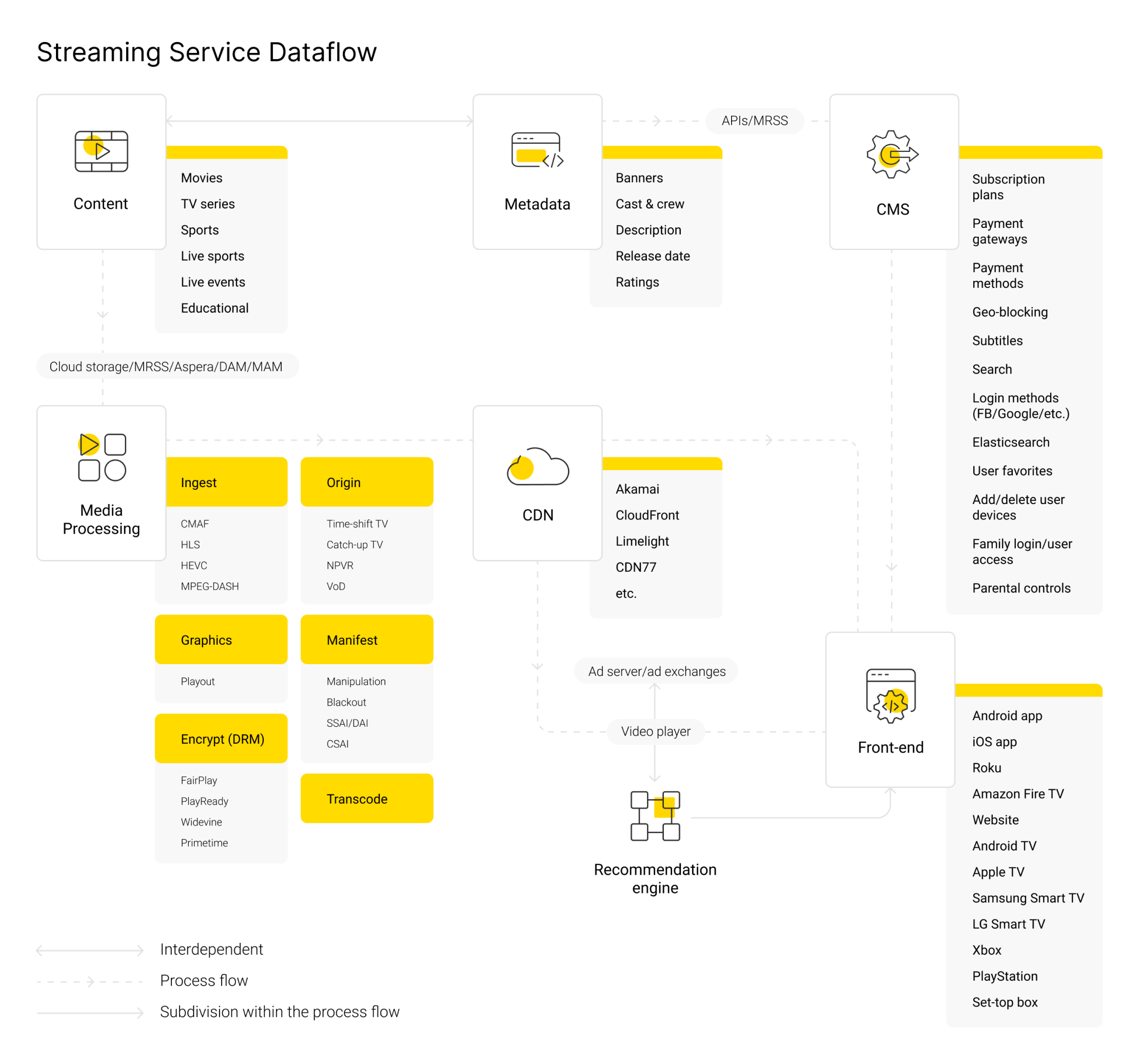- What is a CTV?
- How is CTV better than traditional TV?
- What are the challenges in launching Connected/Smart TV apps?
- Looking to get started?
The adoption of Connected TV (CTV) is surpassing that of traditional or Linear TV with each passing day. Approximately 83% of the households in the US are already using this technology, which indicates the importance and dominance of CTV across the world. Having penetrated the market, CTVs give us an immense potential for advertising. Before we delve into the advertising aspect, let’s first understand more about CTVs.
What is a CTV?
Connected or Smart TVs are devices that use the Internet to enable the streaming of videos like Amazon Fire or Netflix. Gaming consoles and streaming devices like Roku also fall under this category. Here is a shortlist of devices that qualify as a CTV device:
- Android TV,
- Apple TV,
- Roku,
- Amazon Fire TV,
- Samsung TV (Tizen OS),
- LG TV (WebOS),
- Xbox,
- Playstation,
- Google Chromecast, and so on.
The beauty of CTVs is that they support high quality and digital format consumption on demand, which can be tracked very minutely to push relevant content and advertisement to the viewers. The COVID-19 pandemic has spurred the adoption of these devices. As a result, marketers are pumping in money to get viewers' attention in a more scientific way than ever before. No wonder it is called the future of TV.
CTVs also reduce the friction between content consumption across various devices and the advertiser. A viewer can now seamlessly switch between a TV, tablet, phone, or gaming console using a single ID.
How is CTV better than traditional TV?

CTVs are beneficial to end-users and advertisers alike. Let's look at some of the benefits below.
1. On-demand content consumption One of the major benefits of a CTV is that end-users can consume content on demand at a convenient time. This ensures their complete attention. Content can also be paused and saved for consumption at a later stage, which gives people complete flexibility in terms of when to watch. Thus, advertisers can grab their attention and target ads based on various parameters (time of the day, type of content consumed, location, device, age, gender, etc.). All this helps to serve more accurate and relevant advertisements.
2. Cross-device compatibility Since the content consumption can easily be shifted from one device to another using a single ID, it provides a seamless experience to end-users. Many networks also provide iOS and Android applications that allow users to switch from a CTV to a smartphone. Thus, you can consume the same content on the go. The second screen function is also important for CTVs, as approximately 65% of viewers prefer watching advertisements on a bigger screen. This provides the advertisers with more data about the users and, in turn, allows for more targeted ads across various devices at different times of the day.
3. Content for every member of a family Another important aspect of CTVs is that the entire family has access to the type of content relevant to them. A child wants to watch a cartoon show, an adult would rather watch a horror/suspense show, etc. CTVs allow advertisers to understand the demography of the user watching the show and offer specific ads. So, no more irrelevant or embarrassing ads for the entire family. Advertisers can now choose whom to target thereby optimizing their advertising budget.
4. Precise tracking of ads CTVs are a powerhouse of data for advertisers. They have access to such analytics as the number of ads viewed, how much of the ad was viewed, any call-to-action submitted by the end-user, what time of the day and week the ads were viewed, and so on. Using analytics, advertisers or marketers can fine-tune their messaging or ads for the users and make them more effective.
What are the challenges in launching Connected/Smart TV apps?

Smart TVs present a plethora of opportunities. However, they also bring along certain challenges. Let's discuss some of them here.
1. Fragmentation
One of the biggest challenges in Smart TVs is the fragmentation due to various TV manufacturers, operating systems, versions, etc. If we just look at the operating systems and the devices, the headache is quite apparent — Apple TV, Android TV, Fire TV, Roku, Samsung TV, LG TV, Vewd, Playstation, Nintendo Switch, Xbox, Chromecast! Each of these has various versions of operating systems to be looked into and supported. This makes creating a streaming app for Smart TVs challenging and also results in many streaming players choosing to support only a handful of these devices. Version updates are another nightmare that a streaming company has to consider before delving into it.
In addition, it’s not just about supporting these platforms but also about providing a homogeneous user experience. The look and feel of each app on these operating systems and devices should be similar, if not identical. The feature list should also look the same so that end-users do not miss any basic features on these platforms. On top of that, a consumer should be able to play content on one device and resume it on another device or receive a recommendation based on viewing patterns across various devices and not just a single one. The use of voice to perform certain actions or search within the app is gaining prominence around the world. The idea is to make it easy for people to use the app while delivering consistency across all devices and operating systems.
Andersen has rich experience in creating apps, user interfaces, and user experiences for various Smart TVs and operating systems. We can develop various native apps for all of these platforms using React Native technology so that our customers can easily manage them at a later stage. We also specialize in creating bespoke UI/UX for Smart TV apps, having done work for various enterprise companies across the world. Our team of experienced developers adds features to an already existing app or helps our customers expand their user base by developing solutions for any additional Smart TV apps that are not supported yet.
2. Streaming experience
The streaming experience of an end-user can be divided into two parts — user experience and streaming quality. We have already covered most of the points about user experience above. However, one more thing is important for any business looking to launch its own streaming platform — it should provide seamless login and checkout/payment functionality to users on Smart TV apps. Most streaming apps on TV ask end-users to purchase a subscription on mobile apps or websites. Asking the consumer to use multiple devices for activating the subscription creates a potential leakage point in the user experience. The same is true of the login method on these apps. Recently, it has been improved drastically — consumers must simply verify the code shown on the TV app within their website or mobile software. There still seems to be a long way to go before the entire experience is completely seamless.
In terms of the streaming quality and experience, it is imperative to have the same viewing experience on the Smart TV apps as we get on websites and mobile apps. This means that metadata (descriptions, images, and content-related information) should be optimized for various screen sizes and apps. Optimizing the size of metadata, especially posters and banners, will have a direct repercussion on app load times. If CDN (content delivery network) caching of the images or the content is not done properly, the app will take longer to load and result in a poor streaming experience for the end-user. Another challenge that needs to be considered is the size and quality of the videos for Smart TVs. A 1080p video with a bitrate of 1 Mbps will be fine for mobile devices but may not work for Smart TVs and bigger screens. Supporting 4K content with a bitrate of at least 4-5 Mbps is becoming essential for CTVs.
As a streaming business owner, you would need strong encoding and transcoding, as well as a strong CDN and video player to help to compress large media files without compromising on the quality of the video, thereby saving crucial money on bandwidth. The role of a good CDN cannot be stressed enough, as it allows the global reach of the content, irrespective of the devices. We at Andersen are extremely sensitive to these needs and have the best encoding and transcoding technology along with some of the best CDN players in the world like Akamai, Amazon Cloudfront, Limelight, etc. Our team of expert designers studies user experience in detail and plugs any leakages in the user journey. We are already working on technologies of the future to make the entire end-user journey and experience seamless.
3. Security
Security is of paramount importance for content creators and aggregators who have invested a lot of money into either making or buying it. Needless to say, Smart TV apps should provide all the security features that mobile apps offer to prevent any unauthorized access to content. Unauthorized access could be of two main types — downloading the content and circulating it or screen capturing. DRM (Digital Rights Management) solutions prevent both downloading and screen capturing of the content. DRMs are produced by various companies and support only a handful of devices. For example, Google Widevine only works on Android, Android TV, and other Google-developed operating systems; Apple's FairPlay functions only on Apple devices; Microsoft's PlayReady supports the entire Microsoft ecosystem, including Xbox. This makes it challenging for a streaming business owner to implement every single DRM solution in their app and then support them. Each DRM solution also requires the developers to adjust the video player across various devices effectively. There cannot be any leakages in content security.
Andersen provides robust digital security services and delivers multi-DRM solutions that work across all devices and operating systems without the need to manage each of them separately. This makes the entire security aspect of CTVs seamless and easy to maintain. Andersen has already partnered with a range of DRM providers, such as Widevine, FairPlay, PlayReady, Marlin, Primetime, etc. These are all studio-approved DRM solutions and can be used to stream content on various devices around the globe. In case a streaming business owner is interested in adding a new device with DRM or simply wants to implement DRM across all their devices, our team of streaming experts can help with the entire implementation and the upkeep of the solution.

Looking to get started?
We at Andersen will not only develop apps for a Connected or Smart TV ecosystem but also provide all the technology to leverage the apps in order to offer targeted advertisements using cutting-edge technologies. We have partnered with ad servers like SpotX, Google Ad Manager, Freewheel, etc. to provide ads to our customers irrespective of the geography, content type, or demography. We have vast experience in creating slick Smart TV apps for streaming that will complement your go-to-market strategy in the best possible manner with the highest Quality of Experience (QoE). Reach out to us to learn more about how we can add value to your streaming business.



